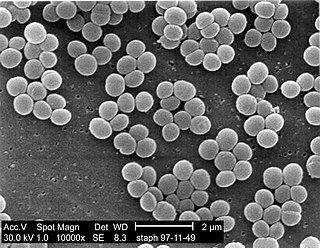
Staphylococcus haemolyticus is a member of the coagulase-negative staphylococci (CoNS). It is part of the skin flora of humans, and its largest populations are usually found at the axillae, perineum, and inguinal areas. S. haemolyticus also colonizes primates and domestic animals. It is a well-known opportunistic pathogen, and is the second-most frequently isolated CoNS. Infections can be localized or systemic, and are often associated with the insertion of medical devices. The highly antibiotic-resistant phenotype and ability to form biofilms make S. haemolyticus a difficult pathogen to treat. Its most closely related species is Staphylococcus borealis.
Leuconostoc is a genus of gram-positive bacteria, placed within the family of Lactobacillaceae. They are generally ovoid cocci often forming chains. Leuconostoc spp. are intrinsically resistant to vancomycin and are catalase-negative. All species within this genus are heterofermentative and are able to produce dextran from sucrose. They are generally slime-forming.

Weissella is a genus of gram-positive bacteria placed within the family Lactobacillaceae, formerly considered species of the Leuconostoc paramesenteroides group. The morphology of Weissella species varies from spherical or lenticular cells to irregular rods. Several strains of Weissella cibaria and Weissella confusa have shown probiotic potential. In particular, the cell-free culture supernatant of Weissella confusa shows a number of beneficial characteristics, such as antibacterial potential and anti-inflammatory efficiency. However, several strains of W. confusa are opportunistic bacteria. A number of studies have been done on the safety of the bacterial species, indicating their probiotic potential. The Senate Commission on Food Safety has validated the use of W. confusa in food.

Staphylococcus is a genus of Gram-positive bacteria in the family Staphylococcaceae from the order Bacillales. Under the microscope, they appear spherical (cocci), and form in grape-like clusters. Staphylococcus species are facultative anaerobic organisms.
Desulfosporosinus is a genus of strictly anaerobic, sulfate-reducing bacteria, often found in soil.
Desulfitobacterium hafniense is a species of gram positive bacteria, its type strain is DCB-2T..
Pedobacter agri is a species of Gram-negative bacteria. Its genome has been sequenced. Its type strain is PB92(T).
Bacillus mojavensis is a bacterium. Bacillus axarquiensis and Bacillus malacitensis are considered later heterotypic synonyms of B. mojavensis. It is named after the Mojave Desert.
Leuconostoc gelidum is a Gram-positive lactic acid bacterium; its type strain is NCFB 2775. Its genome has been sequenced. Its name derives from the fact that it was first isolated from chill-stored meats.
Leuconostoc carnosum is a lactic acid bacterium; its type strain is NCFB 2776. Its genome has been sequenced. Its name derives from the fact that it was first isolated from chill-stored meats. Its significance is that it thrives in anaerobic environments with a temperature around 2 °C, thus has been known to spoil vacuum-packed meat, yet it is not pathogenic and certain strains of L. carnosum are known to produce bactericides known to inhibit or kill Listeria monocytogenes.
Novosphingobium pentaromativorans is a species of high-molecular-mass polycyclic aromatic hydrocarbon-degrading bacterium. It is Gram-negative, yellow-pigmented and halophilic. With type strain US6-1T. Its genome has been sequenced.
Psychrobacter is a genus of Gram-negative, osmotolerant, oxidase-positive, psychrophilic or psychrotolerant, aerobic bacteria which belong to the family Moraxellaceae and the class Gammaproteobacteria. The shape is typically cocci or coccobacilli. Some of those bacteria were isolated from humans and can cause humans infections such as endocarditis and peritonitis. This genus of bacteria is able to grow at temperatures between −10 and 42 °C. Rudi Rossau found through DNA-rRNA hybridization analysis that Psychrobacter belongs to the Moraxellaceae. The first species was described by Juni and Heym. Psychrobacter occur in wide range of moist, cold saline habitats, but they also occur in warm and slightly saline habitats.
Erythrobacter litoralis is a species of bacterium. E. litoralis strain HTCC2594 was first sequenced in 2009. Erythrobacter litoralis strain DSM 8509 was developed as a comparative genetic model system to investigate the role of visible light in regulation of the general stress response in Alphaproteobacteria. The complete genome sequence of E. litoralis DSM 8509 has been published.
Weissella thailandensis is a species of Gram-positive bacteria. It is a homofermentative, sphere-shaped lactic acid bacteria. Its type strain is FS61-1T. Its genome has been sequenced.
Salinibacterium amurskyense is a Gram-positive, non-motile, aerobic, non-spore-forming, irregular, rod-shaped actinobacteria, the type species of its genus.
Leuconostoc pseudomesenteroides is an intrinsically vancomycin-resistant, Gram-positive, coccus-shaped bacterium, with type strain NCDO 768.
Weissella koreensis is a species of Gram-positive bacteria in the family Leuconostocaceae. The bacteria has irregular cells, is tolerant of acid, and does not develop spores. It was described by Lee et al. in 2002.
Oceanobacillus is a Gram-positive, rod-shaped and motile bacteria genus from the family of Bacillaceae with a peritrichous flagella. Oceanobacillus species are commonly found in saline environment.
Commensalibacter is a genus of Gram-negative, aerobic and rod-shaped bacteria from the family of Acetobacteraceae which was originally isolated from Drosophila melanogaster. The complete genome of the type strain C. intestini A911T has been sequenced.


